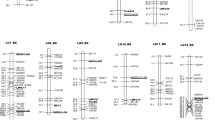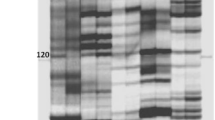Abstract
The recessive mutation of the def gene of pea (Pisum sativum L.) leads to the loss of the hilum, the abscission zone between the seed and the pod. Thereby, it reduces the free dispersal of the seeds through pod shattering. As a prerequisite for a gene isolation via a map-based cloning approach, bulked segregant analysis followed by single plant analyses of over 200 homozygous individuals of a population of 476 F2 plants derived from a cross between 'DGV' (def wild-type) and 'PF' (def mutant), were used to detect markers closely linked to the def locus. The AFLP technique in combination with silver staining was used to maximize numbers of reproducible marker loci. Fifteen AFLP loci showed a genetic distance less than 5 and two of them less than 1 centiMorgans (cM) to the gene of interest. AFLPs were converted into sequence tagged sites (STSs) and into a newly refined AFLP-based single locus marker named the 'sequence specified AFLP' (ssAFLP).





Similar content being viewed by others
References
Bassam BJ, Caetano-Anollés G, Gresshoff PM (1991) Fast and sensitive silver staining of DNA in polyacrylamide gels. Ann Biochem 196:80–83
Bradeen JM, Simon PW (1998) Conversion of AFLP fragments linked to the carrot Y2 locus to a simple codominant PCR-based marker form. Theor Appl Genet 97:960–967
Chalhoub BA, Thibault S, Laucou V, Rameau C, Höfte H, Cousin R (1997) Silver staining and recovery of AFLP amplification products on large denaturing polyacrylamide gels. Biotechniques 22:216–220
Child RD, Chauvaux N, John K, Ulvskov P, Onckelen HA (1998) Ethylene biosynthesis in oilseed rape pods in relation to pod shatter. J Exp Bot 49:829–838
Coyne CJ, Pilet ML, Deniot G, Baranger A, Prioul S, McClendon MT (2000) Selected AFLP primer pairs for fine mapping in pea. Pisum Genet 32:27–30
Doyle JJ, Doyle JL (1990) Isolation of plant DNA from fresh tissue. Focus 12:13–15
Ellis THN (1993) The nuclear genome. In: Casey R, Casey DR (eds) Peas: genetics, molecular biology and biotechnology. CAB International, pp 13–47
ENGAGE Agro Corporation (2002) SPODNAM, for pod shatter control and improved seed quality. www.engageagro.com/media/pdf/label/spodnam_label_english.PDF
Esch E, Weber WE (2002) Investigation of crossover interference in barley (Hordeum vulgare L.) using the coefficient of coincidence. Theor Appl Genet 104:786–796
Garcia-Diaz CA (2000) Birdsfoot trefoil seed production. III. Seed shatter and optimal harvest time. Crop Sci 40:457–462
Gill KS, Gill S, Endo TR, Taylor T (1996) Identification and high-density mapping of gene-rich regions in chromosome group 1 of wheat. Genetics 144:1883–1891
Gualtieri G, Kulikova O, Limpens E, Dong-Jin K, Cook DR, Bisseling T, Geurts R (2002) Microsynteny between pea and Medicago truncatula in the SYM2 region. Plant Mol Biol 50:225–235
Jackson G, Miller J (1999) Dryland spring pea variety performance trial. Western Triangle Agricultural Research Center, Research Reports and Publications, Annual Reports, www.ag.montana.edu/wtarc/Web99/Soil/pea/DLPvar99.htm
Khangildin FK, Khangildin VV (1969) Woprosy genetiki i sjelekcji sjelskohozjajstwienych rastieniej, Ufa
Knapp SJ, Holloway JL, Bridges WC, Liu BH (1995) Mapping dominant markers using F2 matings. Theor Appl Genet 91:74–81
Kosambi DD (1944) The estimation of map distance from recombination values. Ann Eugen 12:172–175
Künzel G, Korzun L, Meister A (2000) Cytologically integrated physical restriction fragment length polymorphism maps for the barley genome based on translocation breakpoints. Genetics 154:397–412
Lander ES, Green P, Abrahamson J, Barlow A, Daley M, Lincoln SE, Newburg L (1987) MAPMAKER: an interactive computer package for constructing primary genetic linkage maps of experimental and natural populations. Genomics 1:174–181
Liljegren SJ, Ditta GS, Eshed Y, Savidge B, Bowman JL, Yanofsky MF (2000) SHATTERPROOF MADS-box genes control seed dispersal in Arabidopsis. Nature 404:766–770
MacLeod J (1981) Harvesting. Oilseed Rape Book, Cambridge, Cambridge Agricultural Publications, pp 107–119
Mano Y, Kawasaki S, Takaiwa F, Komatsuda T (2001) Construction of a genetic map of barley (Hordeum vulgare L.) cross 'Azumamugi' ×'Kanto Nakate Gold' using a simple and efficient amplified fragment-length polymorphism system. Genome 44:284–292
Mao L, Begum D, Chuang H, Budiman MA, Szymkowiak EJ, Irish EE, Wing RA (2000) JOINTLESS is a MADS-box gene controlling tomato flower abscission zone development. Nature 406:910–913
Meksem K, Ruben E, Hyten D, Triwitayakorn K, Lightfoot DA (2001) Conversion of AFLP bands into high-throughput DNA markers. Mol Gen Genet 265:207–214
Michelmore RW, Paran I, Kesseli RV (1991) Identification of markers linked to disease resistance genes by bulked segregant analysis: a rapid method to detect markers in specific genomic regions using segregating populations. Proc Natl Acad Sci USA 88:9828–9832
Moden WJ, Dowding EA, Whitcraft JC, O'Keeffe LJ (1986) Lentil harvesting in the Palouse. American Society of Agricultural Engineers, Paper No. 86–1580
Muehlbauer FJ, Summerfield RJ, Kaiser WJ, et al. (1997) Principles and practice of lentil production. U.S. Department of Agriculture, Agricultural Research Service, ARS – 141
Patterson SE (2001) Cutting loose. Abscission and dehiscence in Arabidopsis. Plant Physiol 126:494–500
Pedersen C, Giese H, Linde-Laursen I (1995) Towards an integration of the physical and the genetic chromosome map of barley by in situ hybridization. Hereditas 123:77–88
Petes TD (2001) Meiotic recombination hot spots and cold spots. Nature Rev 2:360–369
Philbrook BD, Oplinger ES (1986) Soybean field losses as influenced by harvest delays. Agron J 81:251–258
Prins R, Groenewald JZ, Marais GF, Snape JW, Koebner RMD (2001) AFLP and STS tagging of Lr19, a gene conferring resistance to leaf rust in wheat. Theor Appl Genet 103:618–624
Reamon-Büttner SM, Schondelmaier J, Jung C (1998) AFLP markers tightly linked to the sex locus in Asparagus officinalis L. Mol Breed 4:91–98
Roberts JA, Whitelaw CA, Gonzalez-Carranza ZA, McManus MT (2000) Cell separation processes in plants-models, mechanisms and manipulation. Ann Bot 86:223–235
Rozental AJ (1966) Bobowyje i ziernobobowyje kultury. Moskwa
Säll T, Nilsson NO (1994) The robustness of recombination frequency estimates in intercrosses with dominant markers. Genetics 137:589–596
Sanders PM, Lee PY, Biesgen C, Boone JD, Beals TP, Weiler EW, Goldberg RB (2000) The Arabidopsis DELAYED DEHISCENCE 1 gene encodes an enzyme in the jasmonic acid synthesis pathway. Plant Cell 12:1041–1061
Schnable PS, Hsia AP, Nikolau BJ (1998) Genetic recombination in plants. Curr Opin Plant Biol 1:123–129
Shan X, Blake TK, Talbert LE (1999) Conversion of AFLP markers to sequence-specific PCR markers in barley and wheat. Theor Appl Genet 98:1072–1078
Swiecicki WK, Wolko B (1990) Locus for the gene def (DEVELOPMENT FUNICULUS). Pisum Newslett 22:67–68
Tiwari KR, Penner GA, Warkentin TD (1999) Identification of AFLP markers for the powdery mildew resistance gene er2 in pea. Pisum Genet 31:27–29
Vos P, Hogers R, Bleeker M, Reijans M, van de Lee T, Hornes M, Freijters A, Pot J, Peleman J, Kuiper M, Zabeau M (1995) AFLP: a new technique for DNA fingerprinting. Nucleic Acids Res 23:4407–4414
Weeden NF, Ellis THN, Timmerman-Vaughan GM, Swiecicki WK, Rozov SM, Berdnikov VA (1998) A consensus linkage map for Pisum sativum. Pisum Genet 30:1–4
Wen L, Tang HV, Chen W, Chang R, Pring DR, Klein PE, Childs KL, Klein RR (2002) Development and mapping of AFLP markers linked to the sorghum fertility restorer gene rf4. Theor Appl Genet 104:577–585
Zhang Y, Stommel JR (2000) RAPD and AFLP tagging and mapping of Beta (B) and Beta modifier (MoB), two genes which influence β-carotene accumulation in fruit of tomato (Lycopersicum esculentum Mill.). Theor Appl Genet 100:368–375
Acknowledgements
We thank the plant breeding company Pajbjergfonden for kindly supplying the pea breeding line 'Pajbjergfonden 42403'.
Author information
Authors and Affiliations
Corresponding author
Additional information
Communicated by C. Möllers
Rights and permissions
About this article
Cite this article
von Stackelberg, M., Lindemann, S., Menke, M. et al. Identification of AFLP and STS markers closely linked to the def locus in pea. Theor Appl Genet 106, 1293–1299 (2003). https://doi.org/10.1007/s00122-003-1197-0
Received:
Accepted:
Published:
Issue Date:
DOI: https://doi.org/10.1007/s00122-003-1197-0




